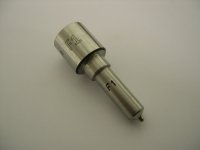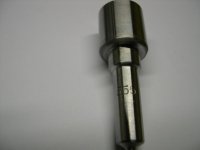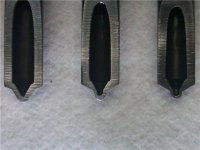I am going to post a few pictures up of the differences between our nozzles and others. I will try and be very concise and easy to understand.
Dont expect a total explanation of what we do and what is different between us and them though.
The first photo is the "F1" stamped nozzle for the 04.5 and up 5.9 engine. This is the same nozzle David has in his engine. His nozzle is a Flux 3.8 in size. I believe the truck runs 11.20's when it is not busted. LOL
To combat copying and other companies stealing our nozzles and calling them theirs. ( yes it happens more than you think ) we have the "F1" stamped into the nozzle stem. It is stamped in during production before the steel is hardened. The stem is the thinnest part of the nozzle that anyone can see when the complete injector is assembled.
Secondly, we have the "F1" NOT stamped, but laser marked on the head of the nozzle after the steel is hardened and the final size grinding is done. There is also a date code lasered on, but that will follow in the next photo with the explanation of what the codes mean.





